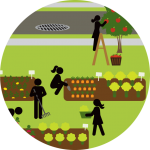
Agriculture & urban agriculture brings food production closer to the table, decreasing emissions associated with long-distance transportation and providing communities with a greater appreciation for where food comes from.
About Agriculture & Urban Agriculture
Agricutlure & urban agriculture refers to a wide variety of food-related activities in and around urban areas. It can take many different forms, including:
- Residential, community and school gardens;
- Orchards;
- Rooftop farms;
- Greenhouses;
- Therapeutic gardens;
- Urban or rural livestock; and,
- Commercial farms.
What Are the Benefits of Agriculture & Urban Agriculture?

Mitigation: Local food production reduces carbon emissions associated with transporting food over longer distances.

Water quality: The soil and vegetation associated with agriculture & urban agriculture can absorb rain water and filter pollutants, improving water quality in urban areas.

Habitat: Flowering plants such as fruit trees and vegetables provide habitat and a food source for pollinating insects and birds.

Physical Health: Urban agriculture provides fresh, nutritious food as well as opportunities for physical activity.
Food Security: Local food production increases overall food security for communities by giving them access to more diverse sources of food.

Social Well Being: Like parks and open spaces, urban agriculture provides opportunities to socialize and cooperate with one another.
Education: Provides education on plant propogation, maintenance and harvesting for our children and youth.

Local Economic Development: Activities related to agriculture & urban agriculture (e.g. farmer’s markets) generate business, which in turn results in local job opportunities and development.

